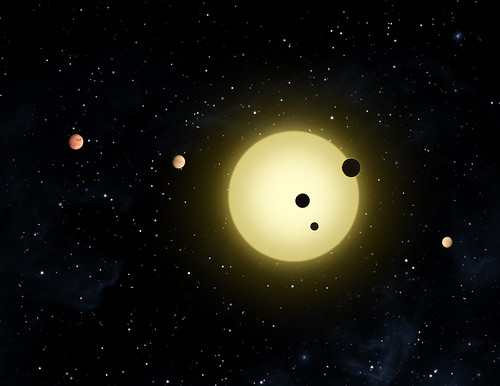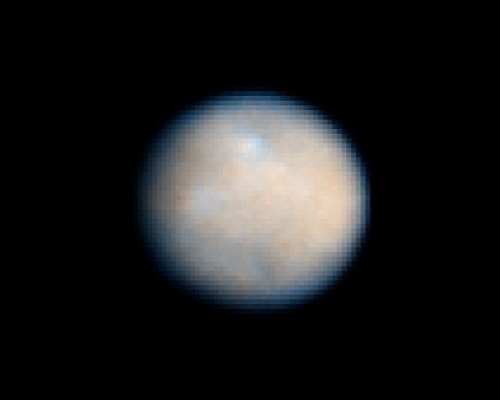Anatomy of an Exosolar System
- By Jillian Brown
- August 3, 2012
- Comments Off on Anatomy of an Exosolar System
A good chunk of the exoplanets that we’ve detected so far are huge, Jupiter-sized and larger. A lot of them are orbiting their stars at very short distances – it might seem strange to think that planets bigger than Jupiter are orbiting their stars closer than Mercury orbits the Sun, to the point where some of them take days or only fractions of a twenty-four hour day to complete one full orbit, but that’s what we’ve actually observed (among other really cool kinds of exoplanets). For comparison, Jupiter takes about twelve Earth years to travel around the Sun once, and these giant Jupiter exoplanets orbit in only fractions of that time. Exoplanets like these are called hot Jupiters, so named of course because while they’re “jovian” (Jupiter-like) in size, their proximity to their parent stars means that their surface temperatures are several hundred times as high as those of our outer planets. Hot Jupiters don’t start out at their sweltering homes though, and how they get there is pretty interesting.
In protoplanetary and debris disks (the millions of miles of stuff around a young star, yet to conglomerate into bigger objects like planets and asteroids), material is concentrated in rings. To maintain that ring structure (rather than have the material swirl out into thinner and thinner strands until an even distribution of matter is achieved), the rings can’t be shaped in perfectly concentric circles. Rather, each ring is tilted just a little to one side with respect to the one inside it, creating a twisting effect that causes some sections along each ring to be bunched up closer together, and some sections to be spaced out farther apart. This causes the matter in these bunched-up areas to be packed more densely than the places spread farther out. Just like how it’s easier to fit ten people into a van than it is into a sportscar, the amount of stuff there is doesn’t change – just how it’s being packaged. It helps to take a look at the diagram to picture this, since there you can really see how the subtle tilts in each ring contribute to the swirling effect.

A diagram of the structure of spiral density waves, credit Dbenbenn and Mysid; distributed via Creative Commons License
This, incidentally, is also what gives spiral galaxies their shape – on a much bigger scale, of course!
While the particles and planetesimals (small rocky bodies that can collide and eventually grow large enough to become a planet) in the denser regions are maintained in orbit by the star’s gravity, they are also all interacting with the gravity of every other object in the disk with them. Because they are all exerting gravity on each other, these dense areas are pulled along together like the cars in a traffic jam: while the cars may move forward, they are all still tightly packed together. Over time gravitational interactions like this pull gas giant planets inward toward their stars – which is what makes them hot Jupiters, completing an orbit in a fraction of the time it took in their original location. And since they’re moving around a lot, these giant planets with formidable gravity of their own often perturb the orbits of other objects in their solar systems, sometimes ejecting them from their orbits entirely! Because of this tendency, hot Jupiters are often observed – meaning, using the limited information we have right now – to be the the only planet-sized objects in their systems.
So far most of the exosolar systems we’ve discovered only have one planet, sometimes two. There are some stars that have been found to have many more, such as the star 55 Cancri: appropriately, it has five known planets. HD 10180 has seven, with two more unconfirmed discoveries just this year, bringing its potential total up to nine planets. While there are undoubtedly millions of exosolar systems in the universe, from what we can tell right now it looks like most of them are much smaller than ours.

An artist’s conception (drawing) of the Kepler-11 exosolar system including six planets, credit NASA/Tim Pyle
Most people are under the impression that exosolar systems are set up by and large like ours is. While it’s true that our solar system is comprised of rocky smaller bodies toward the center and gas giants and icy bodies farther from our star, we’ve discovered through observation and imaging that most exosolar systems don’t seem to share this configuration. It does make sense that people might think this, because for centuries ours was the only solar system we knew about and it was the only basis of comparison we had to draw conclusions from and to make conjectures with. Scientists had that expectation too, actually, and expected similar systems if they were to ever be discovered. But to everybody’s surprise there are all kinds of solar systems orbiting all kinds of stars, and right now ours is one of a small number of identified multiplanet systems.
That’s not to say the others are empty, though. Not at all! They’re still full of stuff. Clouds of dust and gas, or rings of asteroids and ice. Being the only planet hardly means that it’s the only object in orbit. Asteroid belts in particular may be common in systems where a large planet’s gravitational influence has prevented material from “accreting,” colliding with each other taking on more mass and forming planet-sized objects. We actually see this in our own solar system, where Jupiter’s influence on objects in the asteroid belt like Ceres and Vesta prevents them from getting any larger. Systems like this are probably full of planetesimals, small rocky objects that under other circumstances might accrete into planet-sized objects. Maybe even protoplanets, like Vesta and Ceres – these objects started the accretion process, but didn’t get large enough to really be considered planets. Which properly brings up the question: what is a planet anyway? Well, the International Astronomical Union’s famous (and if popular culture is to be believed, highly controversial) definition of the answer to that question in 2006 may have kicked Pluto out of the planet club, but it’s a solid and very reasonable set of criteria; keep in mind that this was the first time that concrete criteria were actually laid out to determine what objects could be classified as planets.

The International Astronomical Union votes on the adoption of a new set of criteria for categorizing planets at the IAU General Assembly of 2006, credit IAU/Lars Holm Nielsen
At the most basic level, for an object in space to be considered a planet, it has to be orbiting a star. From there, it has to be large enough that its own gravity has rounded out the surface – basically, the force of gravity on all the material in a planet creates pressure that pulls it toward the planet’s core, which is why planets (and stars) are round. Asteroids, for example, don’t have enough mass to build up gravity strong enough to pull material toward their cores, which is why they’re all sorts of interesting shapes. This is also how we can tell that objects like Ceres and Vesta were on the road to becoming planets themselves – they’re roundish! But since they didn’t make it all the way there, they’re classified as “dwarf planets.” But the most compelling of these criteria from the standpoint of not only the Pluto debate but also exoplanet science, is that a body has to have also cleared the space around its orbit of other debris. This is what sets Pluto apart from the rest of the planets most convincingly. Pluto’s orbit takes it through sections of the Kuiper belt, a ring of dust and debris beyond the orbit of Neptune. Since Pluto’s travels haven’t impacted the formation of the Kuiper belt enough to clear a path through it, this excludes it from being classified as a planet. But that doesn’t mean that Pluto stopped being cool!
Situations like this may be common in potentially hundreds of exosolar systems with debris disks and asteroid belts of their own, with lots of stuff in orbit. Other planetary systems may not be just like ours, but that doesn’t mean they aren’t worth studying. In fact, you could argue that the because there are so many variables to account for, we should look at as many planetary systems as possible! The more we know about exoplanets, the more we’ll know about how the universe works, and how planetary science applies to other kinds of solar systems as well as our own.

A color image of Ceres snapped by Hubble, credit NASA Hubble, ESA, Southwest Research Institute, Cornell University, University of Maryland, College Park, STScI


